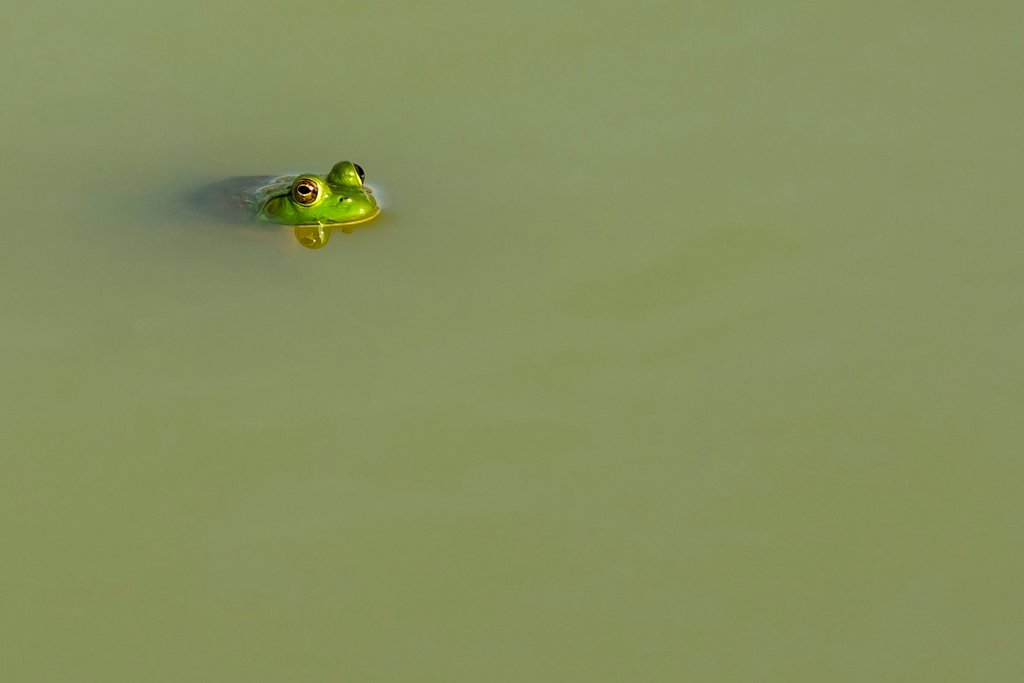
A bullfrog in a farm pond in Kentucky. The Trump administration plans to lay out changes to clean water rules. Education Images/UIG, via Getty Images
WASHINGTON — The Trump administration is expected on Tuesday to unveil a plan that would weaken federal clean water rules designed to protect millions of acres of wetlands and thousands of miles of streams nationwide from pesticide runoff and other pollutants.
Environmentalists say the proposal represents a historic assault on wetlands regulation at a moment when Mr. Trump has repeatedly voiced a commitment to “crystal-clean water.” The proposed new rule would chip away at safeguards put in place a quarter century ago, during the administration of President George H.W. Bush, who implemented a policy designed to ensure that no wetlands lost federal protection.
“They’re definitely rolling things back to the pre-George H.W. Bush era,” said Blan Holman, who works on water regulations with the Southern Environmental Law Center. Wetlands play key roles in filtering surface water and protecting against floods, while also providing wildlife habitat.
President Trump, who made a pledge of weakening a 2015 Obama-era rule one of his central campaign pledges, is expected to tout his plan as ending a federal land grab that impinged on the rights of farmers, rural landowners and real estate developers to use their property as they see fit.
Under the Obama rule, farmers using land near streams and wetlands were restricted from doing certain kinds of plowing and planting certain crops, and would have been required to apply for permits from the Environmental Protection Agency in order to use chemical pesticides and fertilizers that could have run off into those water bodies. Under the new Trump plan, which lifts federal protections from many of those streams and wetlands, those requirements will also be lifted.
A spokesman for the Environmental Protection Agency, John Konkus, declined to comment on the plan.
The clean water rollback is the latest in a series of actions by the Trump administration to weaken or undo major environmental rules, including proposals to weaken regulations on planet-warming emissions from cars, power plants and oil and gas drilling rigs, a series of moves designed to speed new drilling in the vast Arctic National Wildlife Refuge, and efforts to weaken protections under the Endangered Species Act. This week in Katowice, Poland, at an annual United Nations conference on mitigating global warming, Trump administration officials held an event touting the benefits of fossil fuels.
The proposed water rule, scheduled to be announced Tuesday morning at the Environmental Protection Agency, is designed to replace an Obama-era regulation known as Waters of the United States. Tuesday’s unveiling of the proposal is expected to coincide with its publication in the federal register. After that, the administration will take comment on the plan for 60 days, and it could then revise the plan before finalizing it next year.
The Obama rule, developed jointly by the E.P.A. and the Army Corps of Engineers under the authority of the 1972 Clean Water Act, was designed to limit pollution in about 60 percent of the nation’s bodies of water, protecting sources of drinking water for about a third of the United States. It extended existing federal authority to limit pollution in large bodies of water, like the Chesapeake Bay and Puget Sound, to smaller bodies that drain into them, such as tributaries, streams and wetlands.
But it became a target for rural landowners, an important part of President Trump’s political base, since it could have restricted how much pollution from chemical fertilizers and pesticides could seep into water on their property.
The new Trump water rule will retain federal protections for those larger bodies of water, the rivers that drain into them, and wetlands that are directly adjacent to those bodies of water, according to a detailed eight-page fact sheet prepared by the administration ahead of the unveiling of the rule and reviewed by The New York Times.
But it will strip away protections of so-called “ephemeral” streams, in which water runs only during or after rainfalls, and of wetlands that are not adjacent to major bodies of water, or connected to such bodies of water by a surface channel of water. Those changes represent a victory for farmers and rural landowners, who lobbied the Trump administration aggressively to make them.
“The Obama administration led with the premise that all water is connected, all water runs downhill, and the federal government could control all water,” said Don Parrish, director of regulatory relations with the American Farm Bureau Federation, who met with White House officials over the summer to press the case for those changes.
“If they can control the water that falls out of the sky, they control the land that it falls on,” he said.
Mr. Parrish also said the Obama rule chafed its detractors because of the perception it was written by bureaucrats who did not understand the daily reality of farmers’ livelihoods. “The last administration called our concerns silly and ludicrous, and this administration took us seriously. They listened to us,” he said.
In particular, he cited a social media campaign run by the Obama administration, “Ditch the myth,” which challenged the claim that the rule would have regulated water in ditches. “With that campaign, they were laughing at us,” he said.
Mr. Trump won cheers from rural audiences on the presidential campaign trail when he vowed to roll back the Obama rule. Real estate developers and golf course owners (industries in which Mr. Trump worked for decades) were also among the chief opponents of the earlier rule. One of Mr. Trump’s first actions in office was to sign an executive order directing his E.P.A. chief to repeal and replace the rule.
To environmentalists, however, the proposed rule change “upends the core mission of the E.P.A., which is to protect human health and the environment,” said Bart Johnsen-Harris, who works on water policy at the Environment America, an advocacy group.
While the Obama rule would have applied federal protections to wetlands that are not adjacent to major bodies of water, or do not directly drain into them via a surface water channel, the new rule will strip away that protection. That potentially opens millions of acres of pristine wetlands to more pollution, according to Mr. Holman of the Southern Environmental Law Center.
“For wetlands, this is an absolute disaster, compared to the Obama plan,” he said. While such wetlands may not be physically next to major bodies of water, they can still drain into such larger bodies through underground networks, Mr. Holman said.
Stripping away those protections would still allow pollution to seep into the nation’s broader waterways, he said. It would also make it easier for developers to pave over such wetlands.
Federal courts had already halted the implementation of the 2015 Obama-era rules in 28 states after opponents sued to block them. However, in recent months the rules had taken effect in the other 22 states.
The wetland protection policies put in place decades ago by the first President Bush, an avid fisherman, followed on his own campaign pledge to save wetlands, saying, “all wetlands, no matter how small, should be preserved,” and proposing a “no net loss” policy. That initial policy was later weakened by Mr. Bush’s own E.P.A., but environmentalists have credited him for elevating the issue.
Fifteen years later, the second President Bush gave regulatory teeth to his father’s proposal, implementing an E.P.A. rule requiring stronger wetlands protection that his father had once envisioned.

